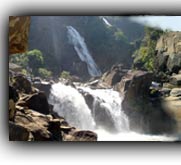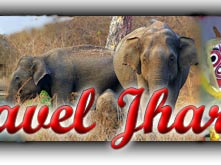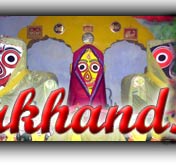 |
 |
 |
 |
 |
- Welcome
- Search TravelJharkhand.com
 Jharkhand is unique in the celebration of fairs and festivals due to its rich tribal culture. Various religious fairs and festivals celebrated throughout Jharkhand. Barura Sharif, Belgada Mela Simaria, Bhadli Mela Itkhori, Chatra Mela, Kolhaiya Mela Chatra, Kolhua Mela Hunterganj, Kunda Mela Pratappur, Kundri Mela Chatra, Lawalong Mela, Rabda Sharif, Sangat and Tutilawa Mela Simaria are some of the prominent fairs and festivals of Jharkhand. Important festivals of Hindus celebrated in Jharkhand are Holi, Divwali, Dashhara and Ramnavami. Other festivals like Basant panchami, Chath, Jityya Bhaiya Duj, etc. are also celebrated in the state. Specific festivals of the tribes in Jharkhand are Karma, Manda, Sarhul, Jani shikar etc.
Jharkhand is unique in the celebration of fairs and festivals due to its rich tribal culture. Various religious fairs and festivals celebrated throughout Jharkhand. Barura Sharif, Belgada Mela Simaria, Bhadli Mela Itkhori, Chatra Mela, Kolhaiya Mela Chatra, Kolhua Mela Hunterganj, Kunda Mela Pratappur, Kundri Mela Chatra, Lawalong Mela, Rabda Sharif, Sangat and Tutilawa Mela Simaria are some of the prominent fairs and festivals of Jharkhand. Important festivals of Hindus celebrated in Jharkhand are Holi, Divwali, Dashhara and Ramnavami. Other festivals like Basant panchami, Chath, Jityya Bhaiya Duj, etc. are also celebrated in the state. Specific festivals of the tribes in Jharkhand are Karma, Manda, Sarhul, Jani shikar etc.
Fairs in Jharkhand
Kunda Mela in Pratappur: This mela is held at the time of falgun Shivratri and is marked by a big sale of cattle.
Kolhua mela in Hunterganj: It is an ancient fair held twice in a year during Magh Basant panchami and chait ramnaumi respectively. There is a beautiful lake and ancient temple of Goddess Kali on the top of the hill. Its origin is not known. It is only a religious fair.
Chatra mela: This mela is said to have started from 1882 and is principally a cattle fair held during Durga Puja.
Kundri Mela in Chatra: The probable year of its origin is 1930 and is held on Kartik purnima and is principally a cattle fair.
Kolhaiya Mela in Chatra: The probable year of origin is 1925. It is held on Magh Basant panchami and is principally a cattle fair.
Tutilawa Mela in Simaria: The probable year of origin is 1935 and is principally a cattle fair held on Falgun purnima.
Lawalong mela: The probable year of its origin is 1880. It is held at the time of Aghan purnima.
Belgada Mela in Simaria: The probable year of its origin is 1920 and this is principally a cattle fair held in Baisakh purnima.
Bhadli mela in Itkhori: There is an ancient temple of Goddess Kali and lord Shiva. The origin of the mela is not known. It is only religious gathering on Makar Sankaranti.
Sangharo Mela in Chatra: It is held in Sawan Purnima. The origin of this fair is not known.
Barura Sharif: Barura Sharif is a shrine on the bank of Sat Bahini river in Pratappur. It is said that the sufi saint came here in the latter half of the 18th century. The Hindus and the Muslim alike come here to pay respect to the reverend saint at his Mazaar. People suffering from evil spirits come here in large number and get themselves cured.
Rabda Sharif: There is a Mazaar (Shrine) of Data Faham Khyal Shah at Rabda Sharif in Pratappur who was contemporary to Data Amir Ali Shah of Barura Sharif. Here annual fair of the saint is celebrated with pomp and grandeur.
The Graveyard of Jatrahibagh: In Jatrahibagh there is a graveyard .It is said that Muslim soldiers of the 1857 mutiny were buried here. It is also known as Anjan Shahid. During British period annual fair was held, hence it is called Jatrahibagh.
Sangat: In Gudri Bazar Mohalla of Chatra there is a Sangat of Udasi Panth of Sikh doctrine where there is an old script of the Holy Gurugranth Saheb. It is venerated at this place and is kept in high esteem by the Sikhs and the Hindus as well. Thus, Chatra is an emblem of communal harmony where the Hindus, the Muslims and the Sikhs reside in peace and harmony.
Festivals in Jharkhand
Sarhul is a festival where Shaal tree and leaves play an important role. Sarhul is celebrated during the spring season when the Shaal trees get new leaves. Shaal flowers are brought to saran sthal (the sacred place) and pahan propitiates the Gods. The priest is called Pahan and he distributes shaal flowers to every villager. The shaal flowers represent the brotherhood and friendship among villagers. It is believed that the earth becomes fertile after this festival as such sowing is taken up.
Santhals, the largest community in Jharkhand, celebrates the same festival as the festival of flowers and calls it Baha. Besides sal, mahua flowers are also used as an important item for the rituals. Santhals celebrate Sohrai with grand festivity. It is preceded by Dansi.
Dansi coincides with Durga Puja while Sohrai is celebrated immediately after Diwali or Kali Puja. Dansi is a dance festival, though not an elaborate ritual function. A small ritualistic act is observed before the dance begins at akhara.
Sohrai is known for the care of domestic animals such as cows and buffaloes. Since these animals are significant in an agricultural society, taking proper care and welfare of them form important ritual of Sohrai. It is celebrated immediately after diwali, on the new moon day. In the evening, earthen lamps are lighted. The next day the cattle are washed, vermilion mixed with oil is put on the cattle and they are garlanded. The festivities include such games as bull fights.
Karma is another festival in Jharkhand that has a close link with nature. Karam Devta, the God of Power, youth and youthfulness is worshipped during the festival. The festival is held on the 11th day of the phases of moon in the Bhadra month. Young girls celebrate this festival for the welfare of their brothers. This ritual is known as jawa. This is held mainly in expectation of good fertility and better household. The unmarried girls decorate a small basket with germinating seeds. It is believed that the worship for good germination of the grains would increase the fertility. The girls offer green melons to the Karam deity as a symbol of ‘son’ which reveals the primitive expectation of human being, i.e. grains and children. On the day of festival, brothers bring branches of karam tree that are placed in the courtyard. These branches, symbolizing Karma god, are worshipped by the sisters. These are ceremoniously immersed in a local pond or river the next day. During this entire period people sing and dance in groups. The entire valley seems to be dancing with the drumbeats. This is one of the rare examples of such a vital and vibrant youth festival in Jharkhand’s Tribal area. The entire tribal area of Jharkhand becomes tipsy during this time.
Tusu Parab or Makar: This festival is mostly seen in the area between Bundu, Tamar and Raidih area of Jharkhand. TUSU is a harvest festival held during the winter in the last day of Poush month. It is also for the unmarried girls. Girls decorate a wooden/ bamboo frame with coloured paper and then contribute it to the nearby hilly river.
Hal Punhya: Hal Punhya is a festival which begins with the fall of winter. The first day of Magh month, known as “Akhain Jatra” or “Hal Punhya”, considered as the beginning of Ploughing. The farmers, to symbolize this auspicious morning plough two and half circles of their agricultural land this day is also considered as the symbol of good fortune.
Bhagta Parab: This festival comes between the period of spring and summer. Among the tribal people of Jharkhand this festival is best known as the worship of Budha Baba. People fast during the day and carry the bathing Pahan the priest, to the tribal mandir called Sarana Mandir. The Pahan sometimes called Laya, gets out of the pond, the devotees make a chain, locking their thighs with each other and come forward to offer their bare chest to Laya for walk over. After the worship in the evening, devotees take part in dynamic and vigorous Chhau dance with lots of gymnastic actions and masks. The next day is full of primitive sports of bravery. The devotees pierce hooks on skin and get tied at one end of a long horizontal wooden pole, which is hanging on the top of a vertical Shaal wood pole. The height goes up to 40 feet. The other end of the pole which is connected with a rope is pulled around the pole by the people and the tied devotee display the breath-taking dance in the sky. This festival is more popular in the Tamar region of Jharkhand.
Rohin: This festival is perhaps the first festival of Jharkhand in the calendar year. It is a festival of sowing seeds in the field. Farmers start sowing seeds from this day but there is no dance or song like other tribal festivals but just a few rituals. There are some other festivals like Rajsawala Ambavati and Chitgomha which are also celebrated with Rohin.
Bandna: Bandana is one of the most famous festivals celebrated during the black moon month of Kartik (Kartik Aamavashya). This festival is mainly for the animals. Tribals are very close with animals and pets. In this festival, people wash, clean, paint, decorate feed well and put ornaments to their cows and bulls. The song dedicated for this festival is called Ohira which is an acknowledgement for animal’s contribution in their day-to-day life. The belief behind this festival is animals are integral part of life and have souls as human being do. The most exciting day of the bandana week is the last day. Closured Bulls and buffalos are chained to a strong pole and they are attacked with a dry animal Hyde. The angry animals hit the dry skin with itchier horns and the crowd enjoys. Generally the colours used for decorating animals are natural colours and this artwork is of folk type.
|
Home COPYRIGHT © 2008 TravelJharkhand.com | | Designed and Developed by GIGISOFT Solutions |